Mechanisms of Hormone Action
Objective 2
List the major chemical classes of hormones of the body. Relate the mechanism of hormone action to the biochemical nature of the hormone.
Water-Soluble vs Lipid-Soluble Hormones
Hormones can be divided into two major groups based on their chemical structure. The first group includes hormones derived from amino acids. This group includes amines, peptides, and proteins. These are water-soluble hormones. Examples of water-soluble hormones include epinephrine, norepinephrine, antidiuretic hormone, and follicle-stimulating hormone. This is not a total list but just examples. We will be learning more about these hormones as we proceed through this unit.
The second group are lipid-soluble hormones, which include steroids. Examples of these hormones include testosterone, estrogen, and cortisol. While thyroid hormones have large amounts of the amino acid tyrosine, they also have a benzene ring, which makes them lipid-soluble.
The mechanism of action the hormone depends on its water solubility. This is very important to keep in mind when determining how the hormone will act on a target cell. In Unit 4 and Unit 13 we saw how charged, polar molecules cannot diffuse directly through the cell membrane. On the other hand, small, non-polar molecules can diffuse directly through the cell membrane. These lipid-soluble hormones then bind directly to intracellular receptors.
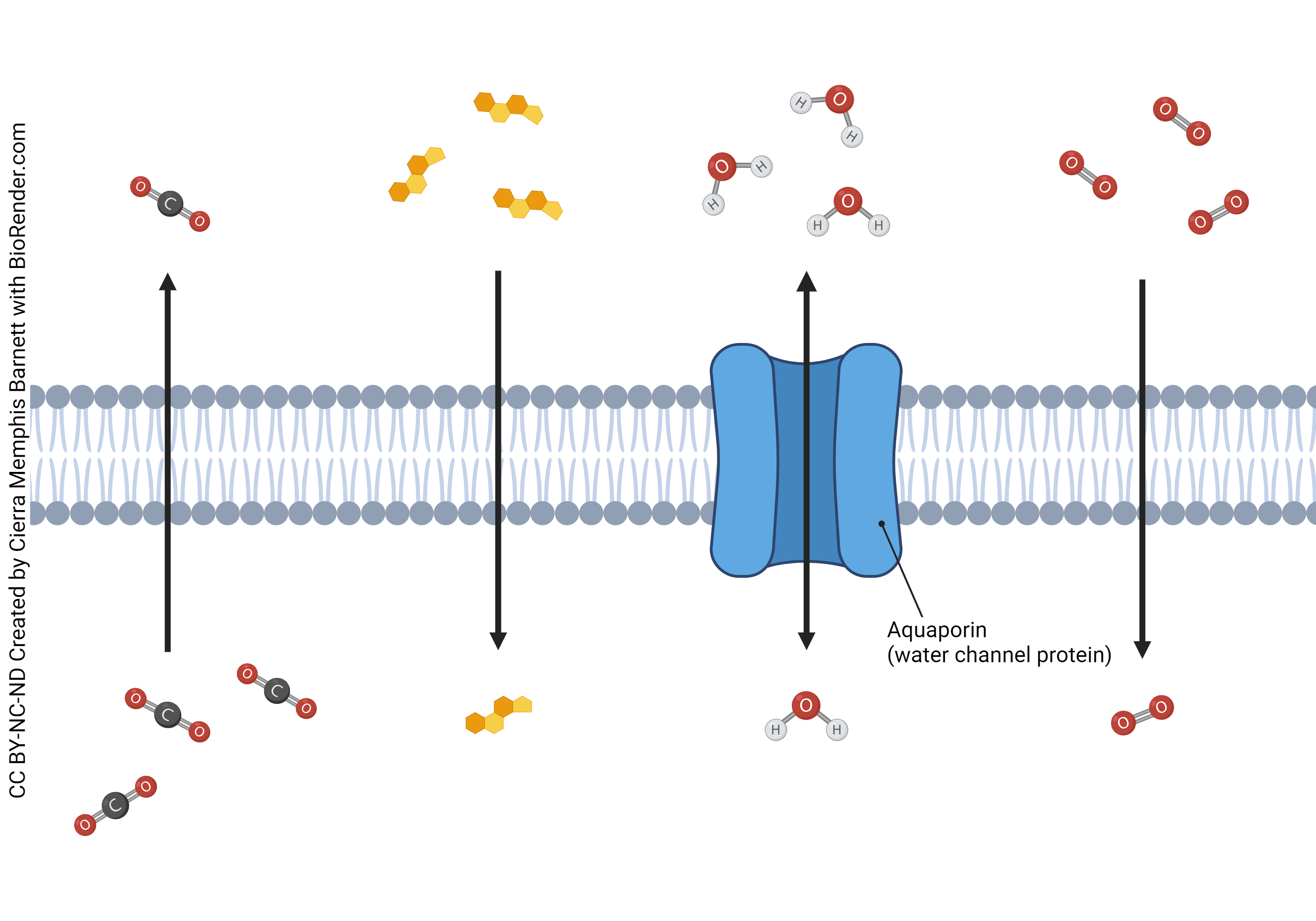
Water-Soluble Hormones: Mechanism of Action
Water-soluble hormones cannot diffuse through the cell membrane but must stimulate a cellular change by a more complex mechanism. They must bind to membrane receptors and initiate a change in the cell indirectly via a G protein-coupled receptor (GPCR).
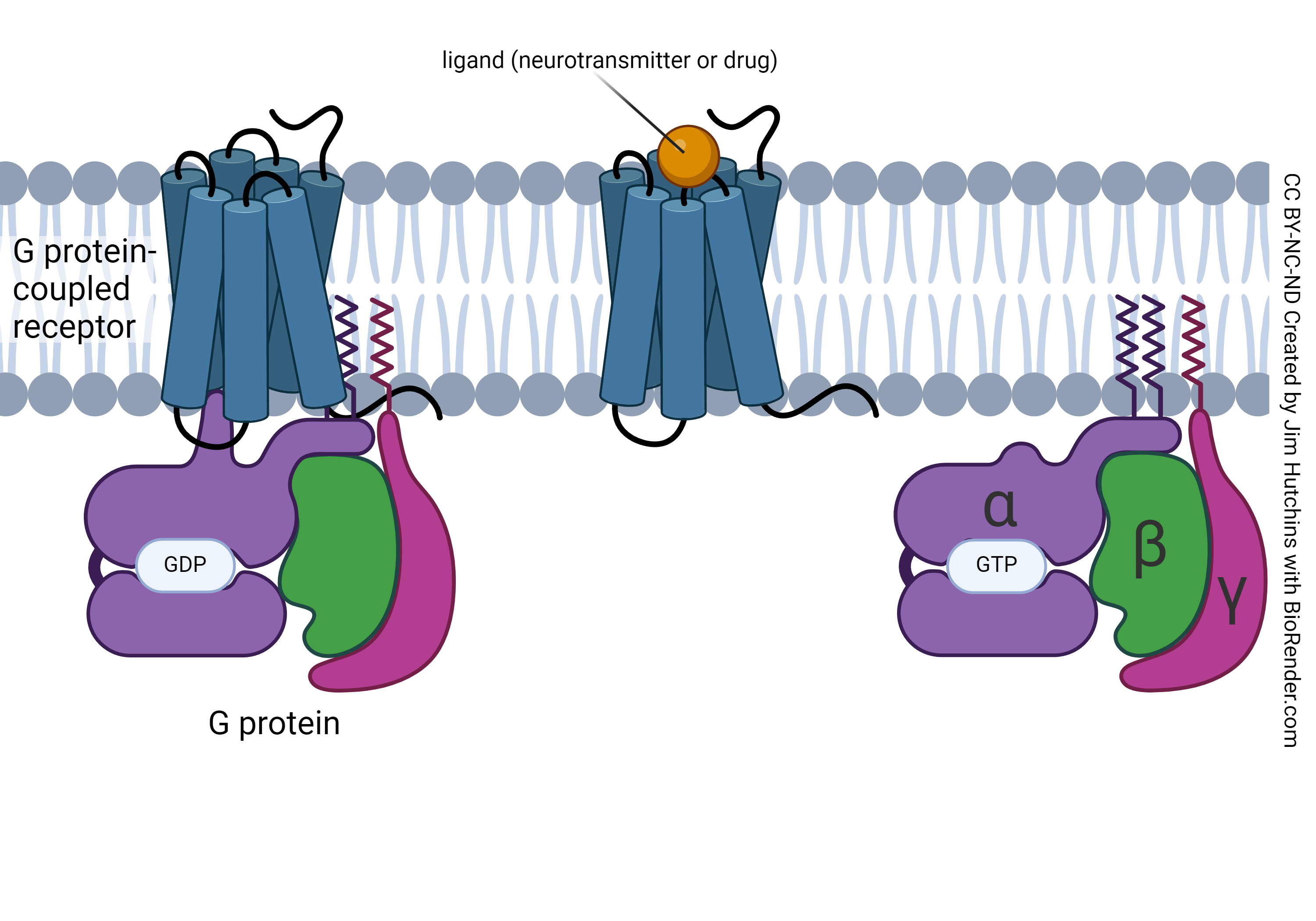
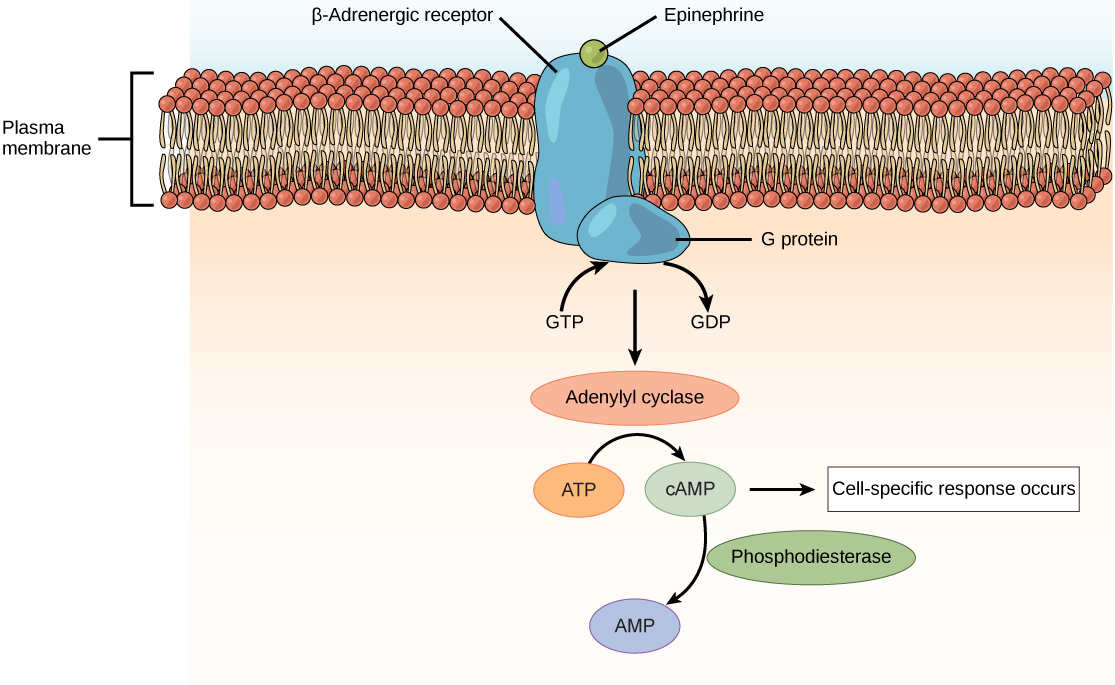
Here are the steps required for a water-soluble soluble hormone to initiate a cellular change:
- Hormone (first messenger) binds to a receptor on the cell membrane.
- By forming a receptor-hormone complex, a membrane protein called G protein is activated.
- The activation of the G protein will then activate the enzyme adenylate cyclase.
- Adenylate cyclase converts ATP into cyclic adenosine monophosphate (cAMP).
- cAMP acts as a second messenger by activating one or more protein kinases.
- Kinases phosphorylate (add a phosphate to) proteins which either activates or deactivates the protein (hormones can be excitatory or inhibitory). There are many different type of kinases, so the effects can be numerous.
- To limit the duration of the response, unless new hormone binds to the receptors, an enzyme called phosphodiesterase inactivates cAMP.
Lipid-Soluble Hormones: Mechanism of Action
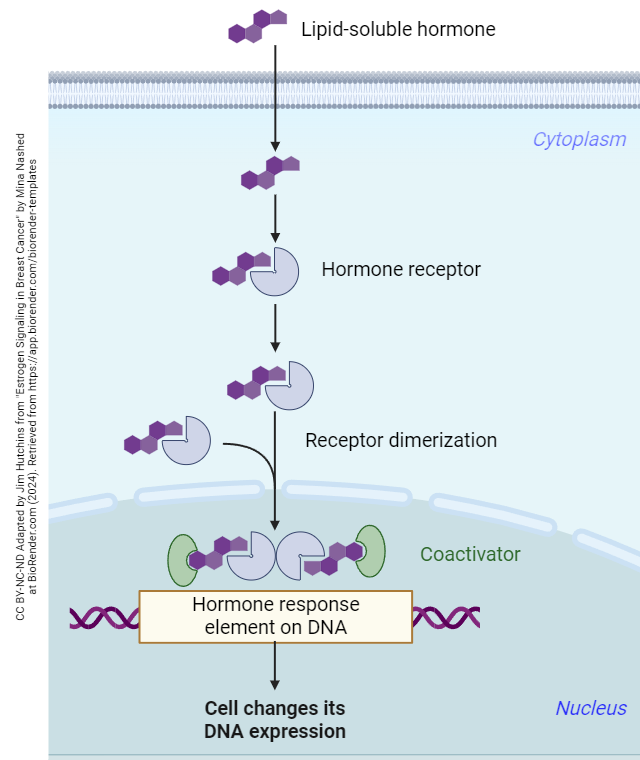
The action of the lipid-soluble hormones is the easiest to understand. Again, because they are lipid-soluble, they can diffuse through the lipid bilayer of the cell membrane. This gives them the opportunity to bind directly to intracellular receptors. The mechanism by which a lipid-soluble hormone works is as follows:
- The hormone diffuses through the cell membrane.
- Hormone can bind to a receptor and create a receptor-hormone complex within the cytosol or nucleus.
- This complex can modulate transcription, altering the gene expression of the cell by turning the genes encoded by the cell’s DNA on or off. Therefore, depending on the type of receptor the hormone binds to, it can be excitatory or inhibitory in that cell. The end result is the alteration of the cell’s activity.
Alteration of gene expression by lipid-soluble hormones can have long-term or permanent effects. For example, testosterone targets the larynx in males during puberty causing lengthening and thickening of the vocal folds. Voice cracking may be an embarrassing result. Testosterone causes long-term effects as the voice deepens. The same long-term hormone effect also happens in women as estrogen targets breast development.
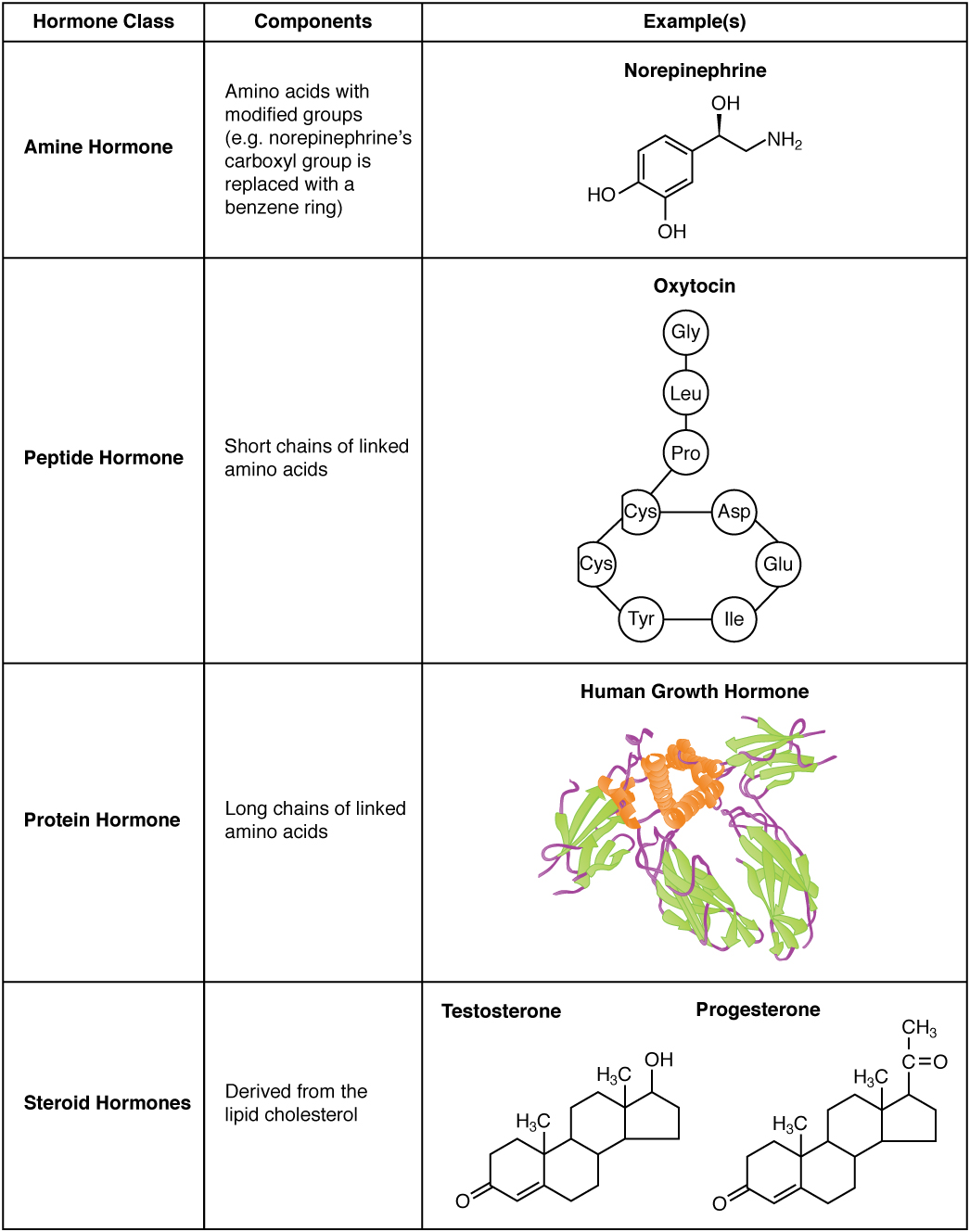
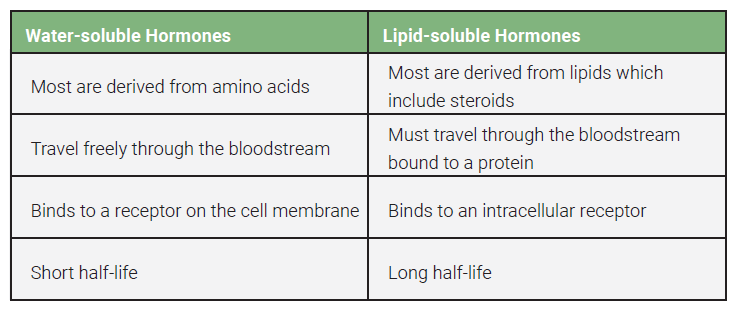
Solubility also dictates how hormones will be carried in the blood. Blood is approximately 55% plasma, and plasma is 92% water. In this watery environment, water-soluble hormones can circulate as “free” hormones; they aren’t attached to any other molecules.
In the blood, lipid-soluble hormones must be bound to transport proteins. By binding to these proteins, the water solubility of these hormones is increased. The transport proteins also keep the smaller lipid-soluble hormones from getting filtered in the kidney and lost in the urine. Where most of the water-soluble hormones are free in the blood, only 0.1-10% of lipid-soluble hormones are free.
The half-life of a hormone is defined as the time required for half the concentration of the hormone to be degraded. Water-soluble hormones don’t stick around for long. For example, epinephrine’s half-life is approximately one minute. The more complex structure of a lipid-soluble hormone bound to protein prolongs the half-life of these hormones. A hormone that helps regulate the stress response, cortisol, is a steroid and as such, lipid soluble. The half-life of cortisol is about 60 to 90 minutes.
Clinical Connection
You may have heard reports about the dangers of drinking from plastic bottles, or re-heating your food in plastic containers. This is because of a chemical called bisphenol A (BPA). This chemical is used when plastics are manufactured. Problem is, if we ingest this chemical, it disrupts the endocrine system. It is particularly harmful to fetuses, infants, and young children. Harmful effects of BPA include wheezing and aggressive behavior in childhood, altered thyroid effects and male sexual dysfunction (now we’ve caught the guys attention). Neurological delays and cancers have also been associated with BPA exposure. BPA free drinking containers are now readily available.
Media Attributions
- U13-001 Simple Diffusion of Gases © Barnett, Cierra Memphis is licensed under a CC BY-NC-ND (Attribution NonCommercial NoDerivatives) license
- U13-100 G Protein-coupled Receptor Basics © Hutchins, Jim is licensed under a CC BY-NC-ND (Attribution NonCommercial NoDerivatives) license
- U14-008b Epinephrine in the Cell © Molnar, Charles and Gair, Jane is licensed under a CC BY-SA (Attribution ShareAlike) license
- U14-008a Lipid-Soluble Hormone Mechanism of Action © Hutchins, Jim and Nashed, Mina is licensed under a CC BY-NC-ND (Attribution NonCommercial NoDerivatives) license
- U14-006 Amine, Peptide, Protein, and Steroid Hormone Structure © Betts, J. Gordon; Young, Kelly A.; Wise, James A.; Johnson, Eddie; Poe, Brandon; Kruse, Dean H. Korol, Oksana; Johnson, Jody E.; Womble, Mark & DeSaix, Peter is licensed under a CC BY (Attribution) license
- U14-010 Water-soluble vs Lipid-soluble Hormones Table © Newton, Kathy is licensed under a CC BY-SA (Attribution ShareAlike) license

